|

| |
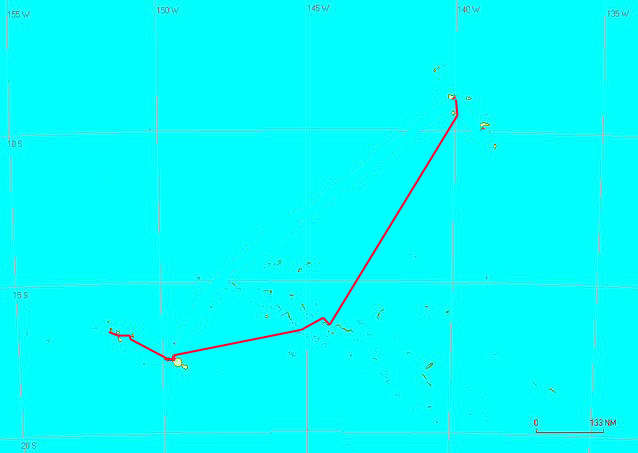
MAKEMO
At the time, I totally omitted talking about
our stay in Makemo, our
first stop in the Tuamotu islands. Unlike most Rally boats, we
had decided together with "Baccus",
"Neva" and "Paramour" to head towards less-frequented islands, and Makemo was
our first stopover; we arrived in front of the Pass heading inside the lagoon
with some concern, the pilot books were full of scary stories about entering the
atolls, but then it turned out that the pass was well-marked and the current not
too fierce, so we went in uneventfully and were then guided by radio from the
other boats to the anchorage.
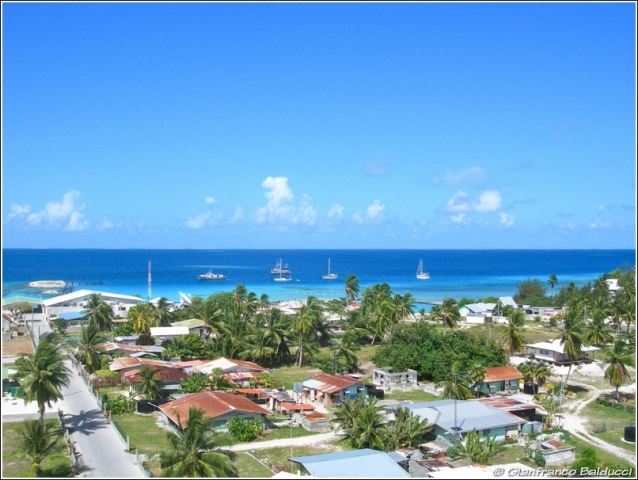
The village as seen from the church's bell-tower; in the
distance, Shaula and other Rally yachts at anchor
It was our first approach with the Tuamotus
and initially the village looked rather un-characteristic, but a walk ashore
around the simple houses, with little kids cheering around us, and a subsequent
dive in the waters of the pass had us hooked.
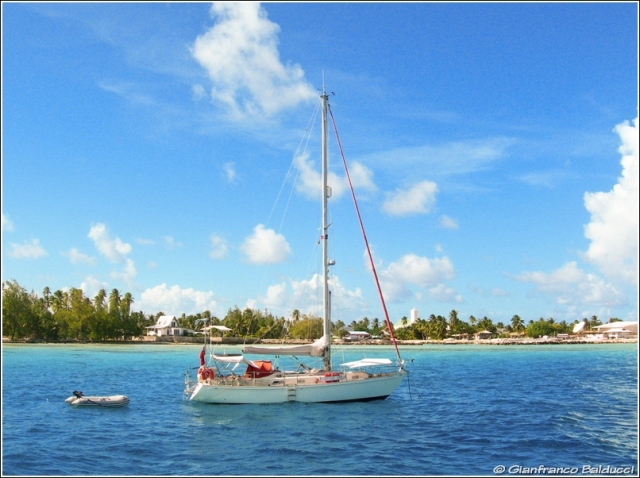
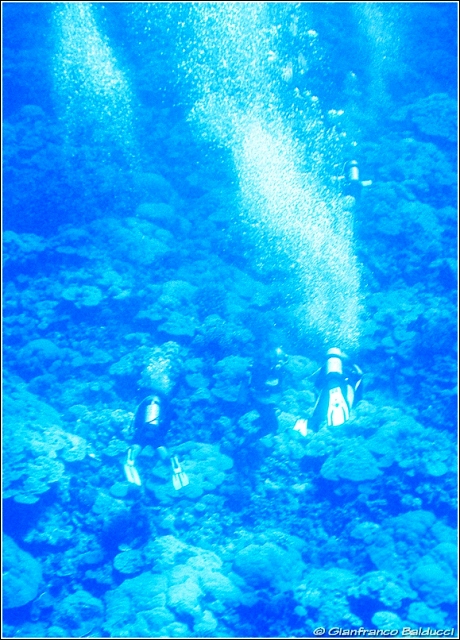
Paramour at anchor in front of Makemo village
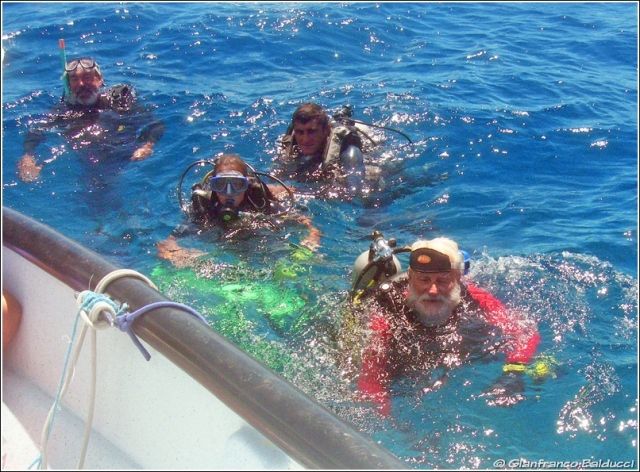
A dive on the reef outside the atoll
We were planning to cross the lagoon to exit
from another pass, but another Rally boat which had tried the same few days
before advised against it, due to the frequent "bommies", sort of coral pillars
reaching near the surface from otherwise safe bottoms, invisible traps for the
unwary sailor!
15/04/2008
PASSES....
So, coral atolls are shaped like rings with an internal lagoon
riddled of rocks and islets.
So far so good, but how do you get inside? In most cases, the coral ring is
irregular and here and there there are passages that are in fact called....
passes!!
Passages yes, but they are not necessarily wide and trouble free, actually most
are narrow, winding and riddled by underwater rocks (called "bommies") that no
cartographer has taken the burden of documenting (and anyway, coral keeps
growing, so it would be a waste of time anyway!!)
An additional problem: due to the tides, the water inside the lagoon goes up and
down and the water flow which is needed to change the water levels can only go
through the passes!
So water flows according to the tide: if it's rising, water should go in, if
it's falling it should go out, and when the tide is reversing the flow should
stop for a little while.
....should, indeed!....
Just to complicate things a little, waves crashing onto the reef from the sea
manage to send additional water inside, and this water must go out from
somewhere.
Obviously, this factor is very changeable, depending on weather conditions.
Result is, water keeps going out also during part (or sometimes all) of the
expected incoming flow.
Very difficult to predict, and in fact nobody even tries to!
The "pilot books" written with sailors in mind try to give some information: "slack
water in this island is one and a half hour after high water", "in this other
it's 5 hours before the moon's passage from the meridian" (what?!), "the
outgoing current may at times reach 15 knots" and other such like amenities,
which generally turn out to be not very reliable!
Result, yesterday at noon I merrily went with the dinghy towards the pass of
Makemo to check how the current was, assuming the slack water to be about one
hour later as suggested by local fishermen.
I was there on the edge of the pass, trying to understand which way the water
was flowing, when all of a sudden I found myself in the middle of the typical
standing wavelets of a strong current which was beginning to flow out, carrying
me with it!! I put the little 3HP outboard at full revs, the dinghy was surfing
on the water, and still I was going backwards!
...It looked really bad: next stop, Hawaii islands?...
Slowly, I went near the shore in the hope of finding a counter-current: no such
thing actually, but the flow was slightly less strong and I was able to zigzag
across the coral in half a meter of water and slowly gain way: "let's hope there
is enough fuel, let's hope the engine will hold, let's hope we do not hit the
bottom, let's hope....".
Well, to cut it short, no Hawaii for this time, but it was a close call!
One hour later, the 4 boats head towards the pass, one after the other: it's one
p.m., the best time according to the fishermen! "Neva" turns the corner... and
speeds away along the pass, pushed by the current! When it's our turn, we find
ourselves running at 11 knots with the rocks on both sides, just to be
catapulted towards huge standing waves at the sea end of the pass, where the
current meets the ocean's waves; we more or less expected it, so we were well
battened-down, but other boats had solid water inside while playing submarine in
these rather dangerous waves.
A relatively uneventful night, and here we are in Tahanea where another pass is
waiting for us: this time, we switch our own brains on, we listen to no
fisherman (also because there is none!), and after having waited half an hour we
get the right moment and get in with not too much trouble.
Now, we are anchored in front of a palm-fronded islet.
A sting-ray just jumped out of the water under Baby's nose.
Water is azure, but really azure.
Paradise, at last!!!
16/04/2008
LEON...
We are in Tahanea, anchored inside the coral reef, near a small pass where the
now abandoned village of Otao once was located. ALMOST abandoned, in fact!
We went ashore with the dinghy, leaving it in a calm inlet which is nearly
reaching the sea on the other side, and then we walked along the shore, Baby
collecting dead corals and shells, until we reached the old village.
And there we met Leon: he lives here, together with another fisherman (his
father?), and they live out of fish and lobster they catch in the pass, few
meters away from shore.
They restored a hut, and even have a deep-freezer powered by a portable
generator; a group of boobies, most of them newborns, is apparently living there
without any fear.
Very kind, Leon, he welcomes us and then gives us directions as to where to
anchor inside the atoll; he has a strange appearance, more japanese than typical
polynesian. He speaks some english, and does not give the impression of being a
cast-off, the hut is well-kept and they are well equipped, in their simplicity.
The sun is going down and the dinghy is waiting in a far-away place, so we greet
Leon and go back, in time to see from our boats the last minutes of the sun
behind the palm trees.
17/04/2008
TAHANEA!!
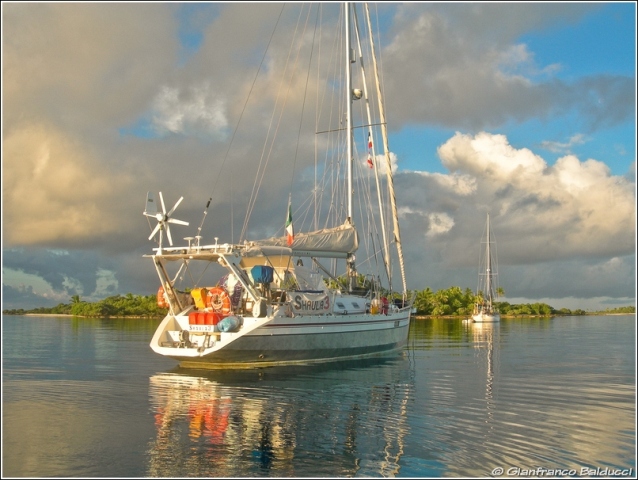
The other day when we arrived here, the group split in two: the anchorage by the
ancient village is very near a small passe and when the tide is rising the flow
of water goes exactly through the anchorage itself, with waves being created by
the wind blowing in the opposite direction. "Neva" and "Paramour", that were
just in the middle of all this, decided to venture inside the atoll in search of
a quieter spot which they found a couple of miles away from "Shaula" and "Baccus"
which had a problem with their anchor windlass that suddenly stopped working. We
were planning to get ashore to visit the ancient village, with the idea to reach
the others the next morning.
...and that's what we did: the new anchorage turned out to be wide and well
sheltered, and the scenery was postcard-like! Small palm-fronded islets, azure
water full of fishes of all colours (today's sightings: "Neva", a 5-feet reef
shark, Baby a moray-eel in one-feet-deep water along the island's shore).
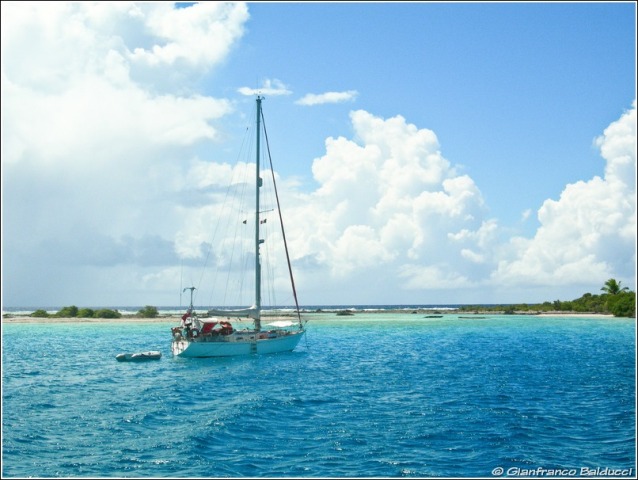
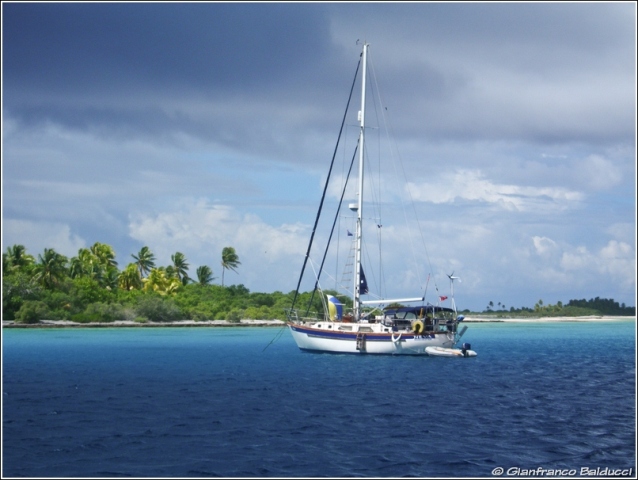
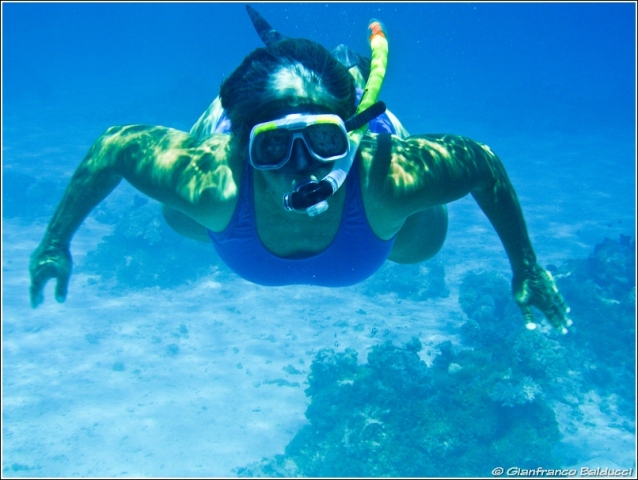
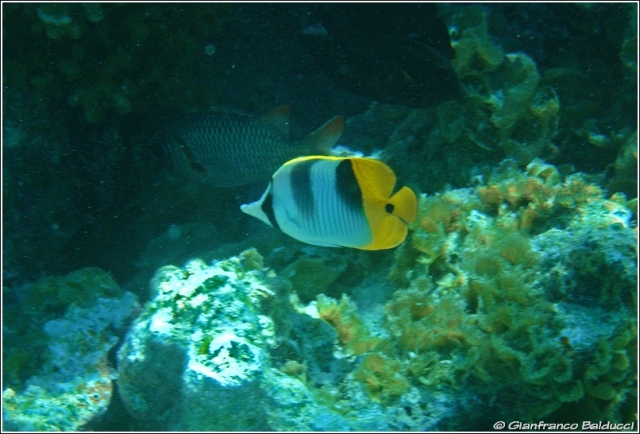
By 3 p.m., all ashore on the nearest "Motu" (that's "island" in the local
language), laden with all the necessary gear to rig barbecues on the beach and
food enough for a platoon of starving marines!
Two rainsqualls (did I say that here it rains very often??) tried to spoil the
fun, but then the sky cleared, the sun was replaced by a pan-sized moon that was
providing day-like illumination, a bonfire on the beach, we circulate a bottle
of "caňa" (a latin-american belly-burning liquor) and we all sit on the beach
staring at nature's show.
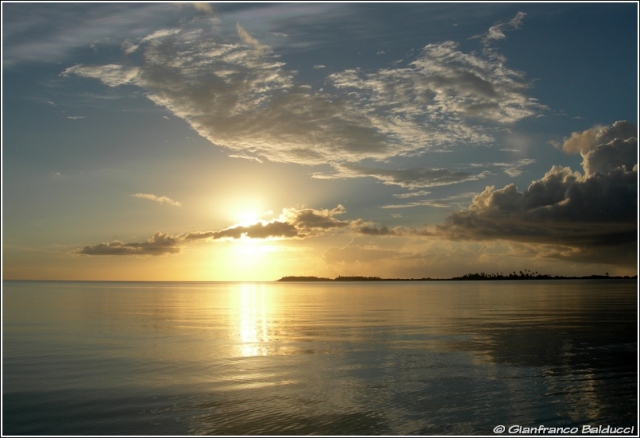
Later, we return to the boats, not without difficulties because the tide has
gone down and now a lot of coral heads are blocking the way threatening the
dinghies' bottoms and the outboards' props, then Peter of "Neva" somehow manages
to fall in the water when going aboard (in a flat calm, we must point out), he
blames the "caňa", then we find ourselves sitting on deck contemplating once more
the scenery under the moonlight.
We were supposed to leave tomorrow to go to another island, but why bother? This
place is wonderful!
Probably we will leave directly from here next saturday to be in Tahiti in time
for the arrival of our son Enrico.
12/05/2008
WINDWARD ISLANDS
Right, once again!
Clearly, the navigators of past times were not very good at inventing new names
and every time they found a group of islands they named them "Windward" and
"Leeward" islands! The worst case is probably that of the Dutch Antilles, which
are at the same time "Leeward" as compared to the other Caribbean islands, but
"Windward" in relation to the other Dutch islands of Curacao, Aruba and Bonaire.
Ok, so also French Polynesia is split between "Windward" (Tahiti, Moorea and a
couple of smaller islands) and "Leeward" (Huahine, Raiatea, Tahaa and, last but
not least, Bora Bora - followed by two smaller, less well-known islands).
Incidentally, they have been called "Society Islands" by Cook himself, in honour
of the British Geographic Society, and the French did not change the name.
Until the early 1900's they had a King, the last one being Pomare 5th who was a
sorry puppet in the hands of the French who managed to make him sign a
protectorate agreement that basically started formally the French domination of
these islands.
Tahiti then: before arriving, we had been warned: very expensive, you will have
to leave because you will run out of money, very touristy, and so on....
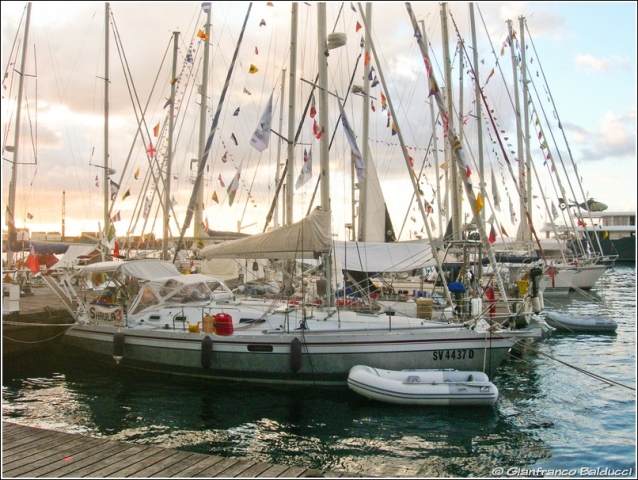
In fact, after months spent at anchor in solitary places, being moored at a
pontoon just 10 meters from Papeete's main road (Boulevard Pomare, nonetheless)
has been a cultural as well as an auditive shock.
The town is actually very expensive, especially for what concerns alcoholic
drinks (a fact that created great concern to some Rally crews...), although for
example it is indeed possible to eat out at reasonable prices at the "roach
coaches", sort of mobile restaurants that are set up every evening in the port
premises. We tried a few, and they were quite good.
Another feature of Papeete is the covered market where they sell mostly fruit,
vegetables and other food, but also souvenirs, tee-shirts and pearls.
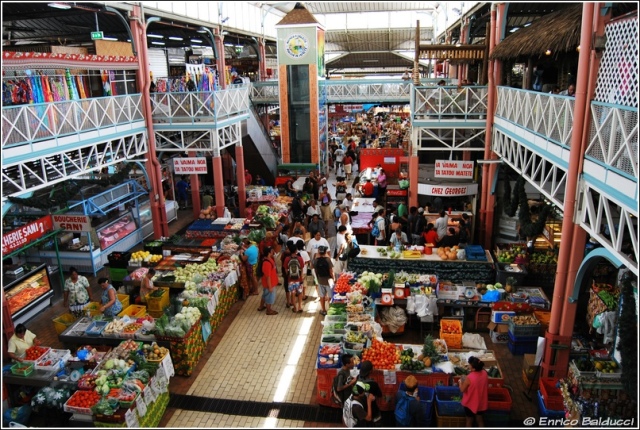
The richly coloured market of Papeete: from fruit and vegs to
clothing and pearls!
Right, the pearls: Polynesia has always been a source of pearls, but now this is
an industry and a smart japanese has introduced a new kind of "nacre" (pearl-making
oyster) that makes black pearls, which have by now become a local trademark.
They are not exactly black, but actually range in colour from dark grey to green.
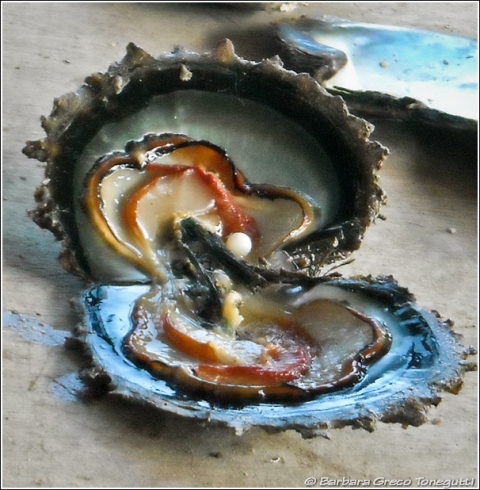
Un-surprisingly, Papeete's main road is full of pricey pearl shops!
Unlike in the Marquesas, the island's shores are densely inhabited: it's very
rare to find a stretch of coast where there is not a home (or an hotel!).
The island's interior by contrast is almost totally un-inhabited, with dramatic
sceneries not much unlike the Marquesas.
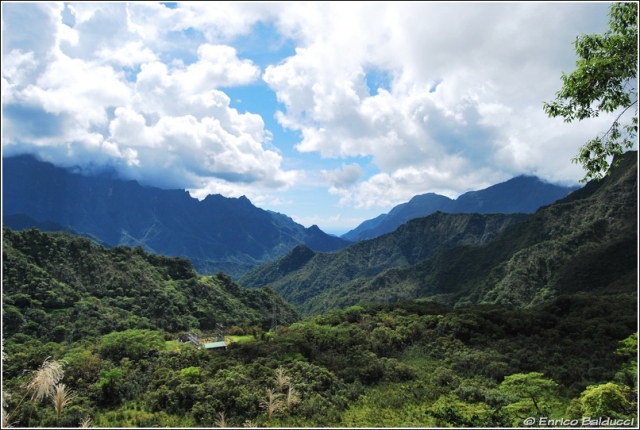
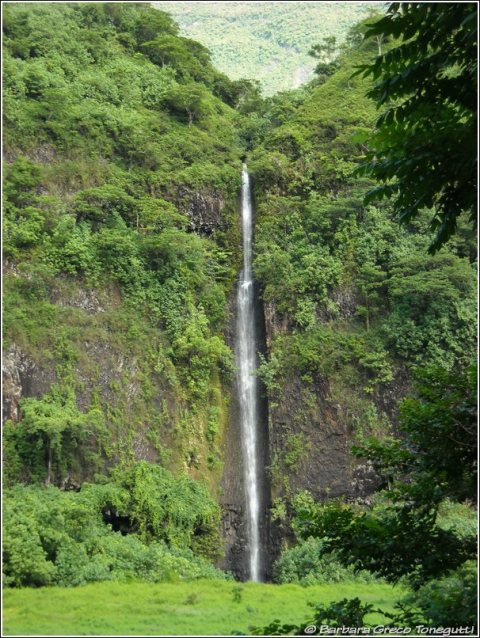
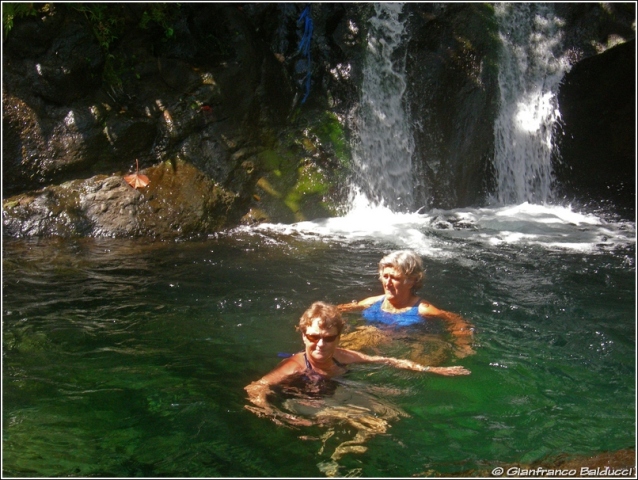
Even more dramatic-looking and more tourist-oriented is nearby Moorea, but here
the tourist infrastructure is discreet and not too evident (with the possible
exception of the 4 or 5 sea-side hotels); anyway, both Cook's Bay (where Cook
has never gone) and Opunohu Bay (where Cook DID actually moor his ship) are two
unforgettable sceneries.
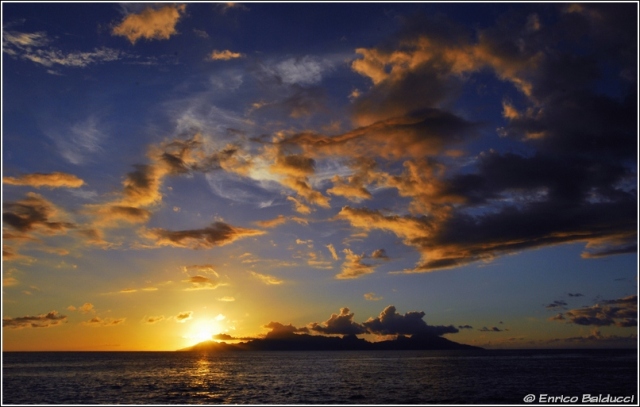
A spectacular sunset over Moorea, viewed from Tahiti
TOURISTS' ENTERTAINMENTS...
While we are at anchor in Cook's Bay, we
cannot escape from some classical tourist attractions, which anyway are feasible
only here, such as feeding stingrays, swimming among the sharks, or opening a
coconut the traditional way.
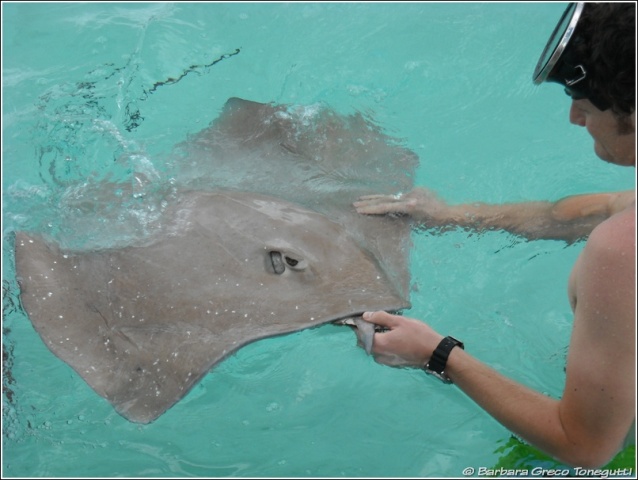
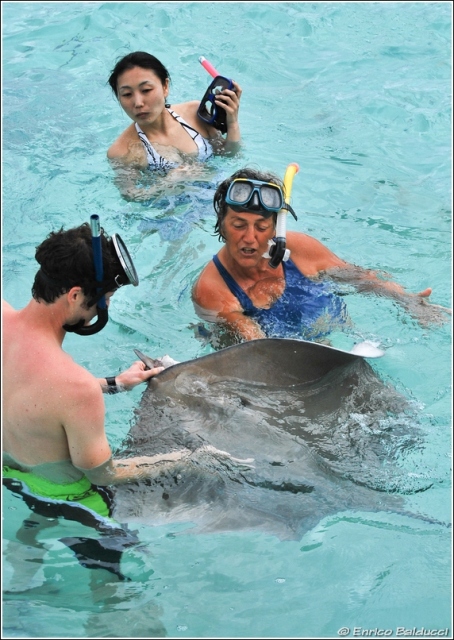
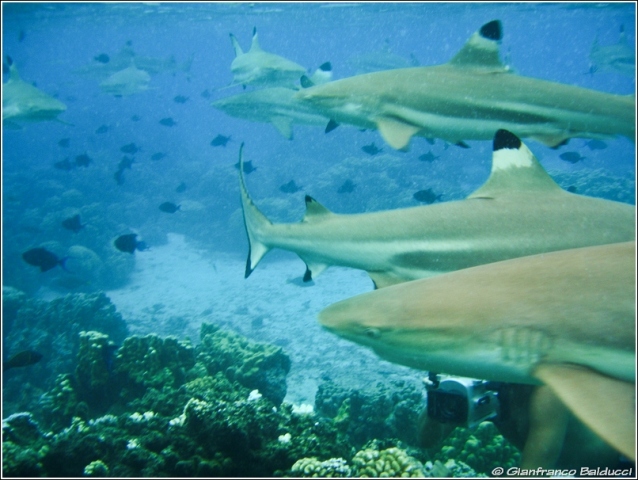
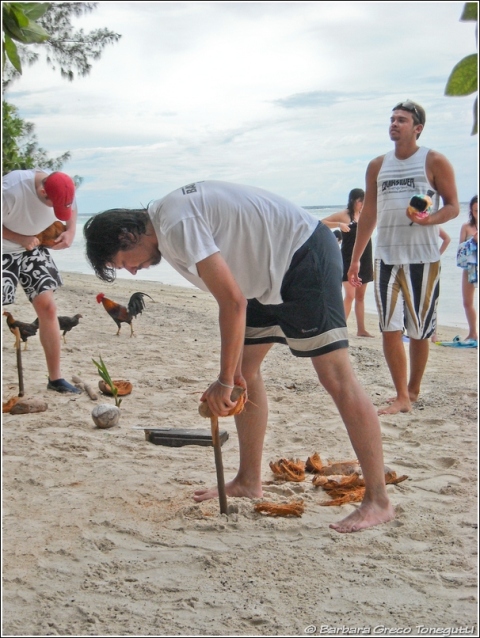
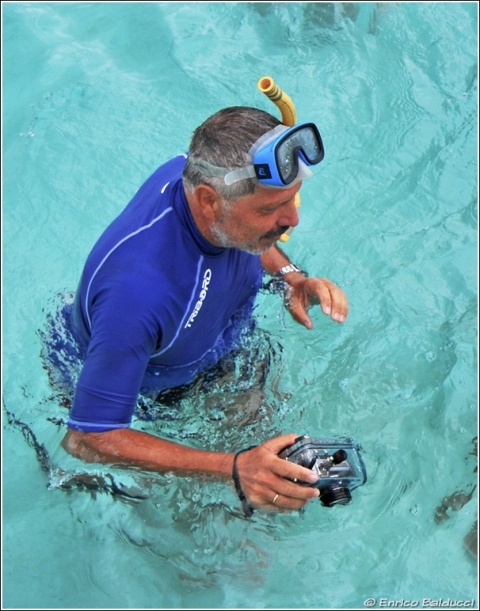
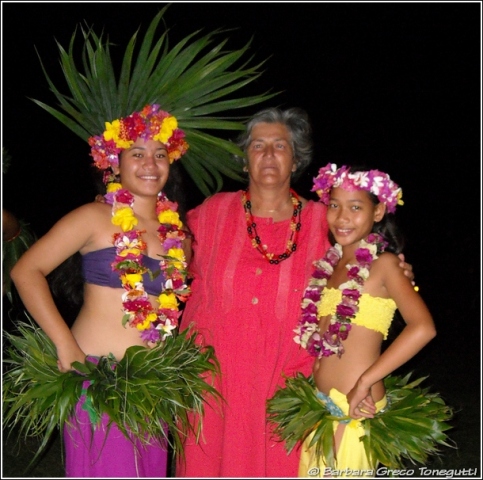
14/05/2008
THE BOUNTY SYNDROME...
Here around one understands why the poor captain Bligh really had no chance,
after a stay of several months, to convince his crew to resume sailing!
After having left Tahiti for good, we dropped anchor in Opunohu Bay, on Moorea,
where we had already been the week before with Enrico: wonderful anchorage
behind the protection of the reef, at the mouth of the very same bay where at
least two editions of the "Mutineers of the Bounty" were filmed (the one
starring Marlon Brando and the one with Mel Gibson).
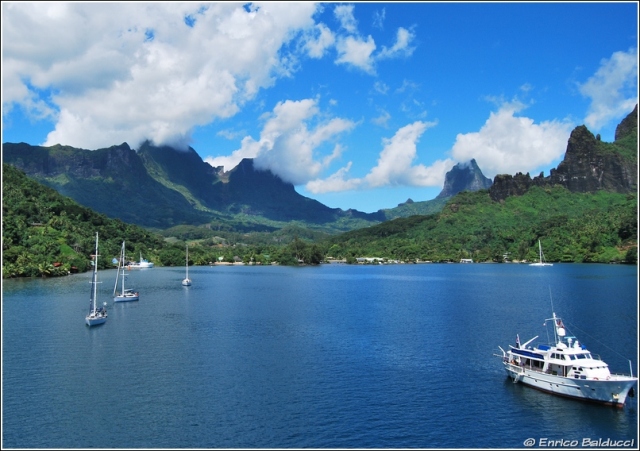
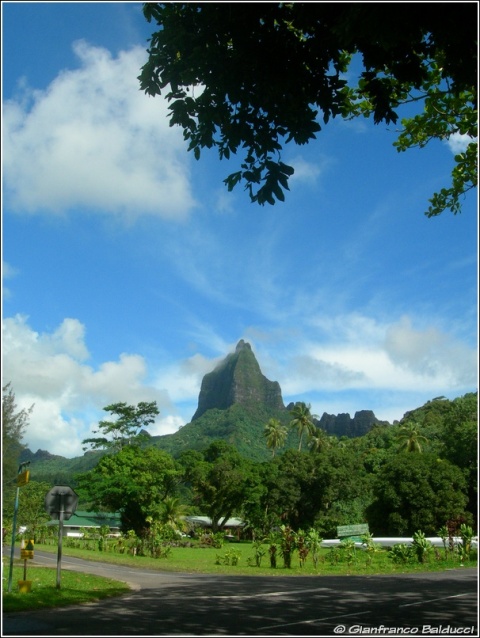
Cook's Bay, Moorea
In reality this harbour is much more beautiful than the place in Tahiti where
the real Bounty was at anchor, not much more than a palm-fringed beach nowadays
called "Venus Point".
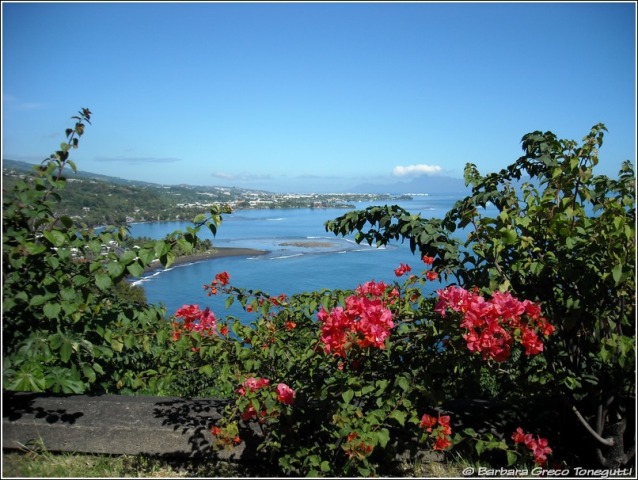
Venus Point, where the Bounty was anchored; there are better
places in Polynesia, but this is not too bad either!
We were supposed to leave the next day, but we caught the first plausible
excuse to stay one more day, and the we had to force ourselves to leave.
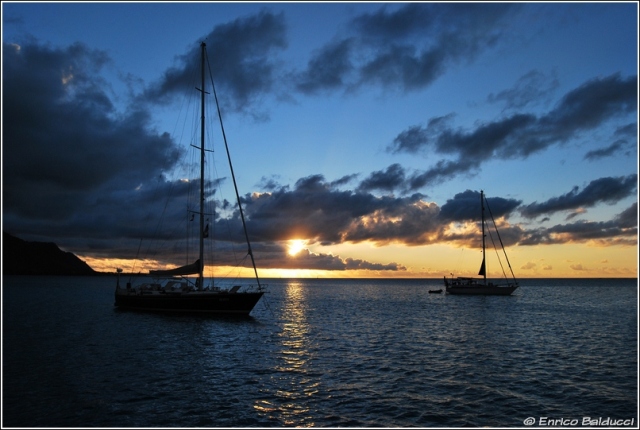
The Gods of the sea (maybe instigated by the spirit of captain Bligh??...)
promptly punished us as we deserved: few hours after departure, we were reached
by an unannounced front, and we spent the whole night trying (not always
successfully) to dodge the rainsqualls!
Once in Huahine, we just entered the passe and immediately dropped anchor in
front of the little village of Fare: there are several attractive anchorages in
the island and certainly the one in front of the village is the least
interesting, but there is a good dinghy dock with garbage disposal (a rarity!!),
a HUGE and well-stocked supermarket, and Wi-Fi INTERNET!! I suspect we will
end-up spending some time also here!
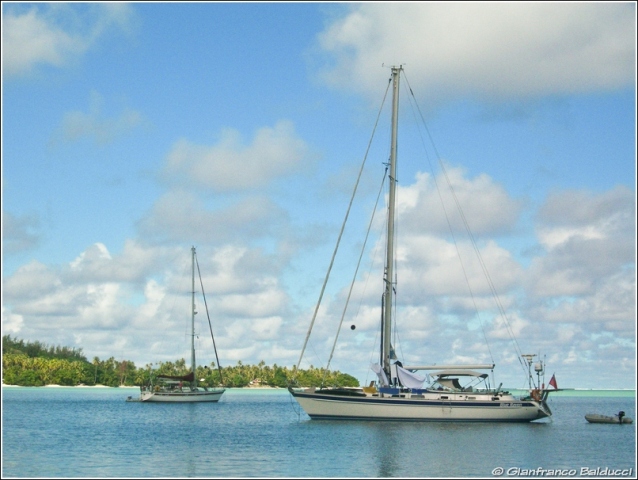
24/05/2008
HEROES AND KITES....
Here around there are a lot of legends concerning the Scorpio constellation,
which, this far south, is high up in the sky; this is one I could not resist:
One of the main characters in the local legends is HIRO, a sort of warrior-semi
god with more than a passing resemblance with the greek mythological hero,
Achilles.
In the old days, kite construction and flying was a serious matter, part of
ritual competitions with a religious significance; so here we have Hiro, who
wants to participate to a kite competition, and his mother, a goddess herself,
gives him advice on which materials to use to build an unbeatable kite.
Once launched, the kite went high up in the sky, and stayed there, steady: Hiro
won the competition, and his kite is remembered ever since, because it is still
there, and it's the Scorpio constellation!
27/05/2008
MARAE AND CRABS...
One of the common features among the Society Islands are the "Marae" (pronounced
"mahrae"): just stone platforms, usually rectangular in shape and anywhere
between 10 and 30 meters wide, usually with an elevated platform on one side.
They can be found anywhere, but most frequently near the shore.
What was their function? Typically, they were meeting places (the powerful
people stood on the elevated platform, while the rest of the people gathered in
front), but in later times they became also the site of religious ceremonies (including
human sacrifices, sometimes - always men, they were smart enough to keep the
women well alive!).
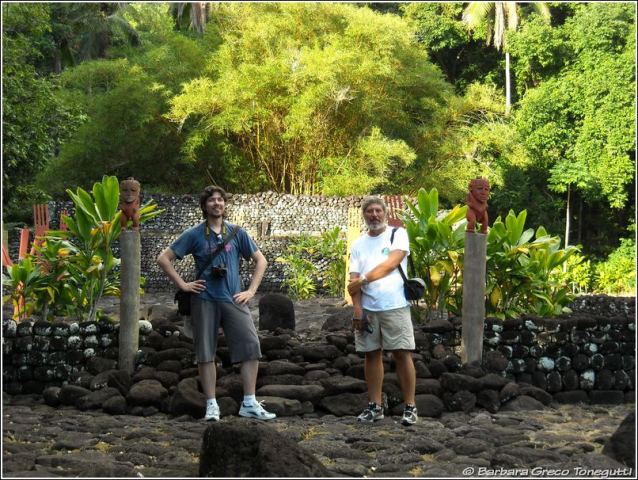
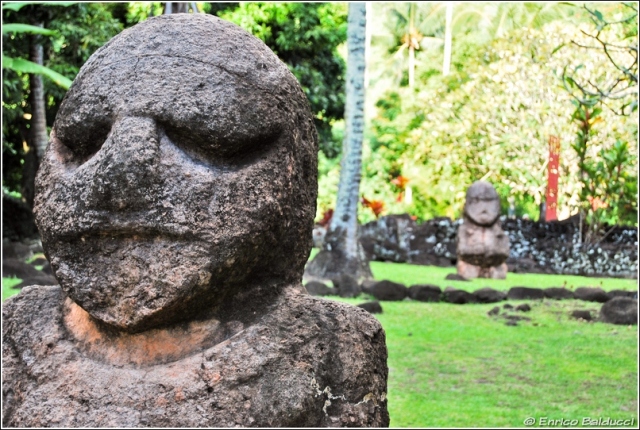
There was a hierarchy between Maraes, with the one in Raiatea, the sacred island
(the first to come out of the sea, according to the legend) which stands above
the others: 3 great stone platforms in a large palm-fronded plain in front of
the sea (rather uncommon in these places). It's very easy to figure the great
gatherings of tribesmen coming from all places aboard their pirogues and camping
on the beach while the chieftains discussed of wars and alliances.
The ground all around the area is full of holes: moles? No, crabs!! Many and
HUGE, they install themselves in the sand, even several tens of meters from the
water (a couple even crossed the paved road in front of our car!).
Oh, by the way, stealing stones from a Marae brings horrendous misfortunes on
the thief: even Barbara did not touch any!!
29/05/2008
THE VAHINE MITH...
Right, the mith of the Polynesian beauty, the Bounty, and all that...
Sorry to say, the majority of Polynesian people may be kind and welcoming, but
they are definitely not good-looking: many are overweight, and the women tend to
fatten with age.
Men sometimes can hide fat in a big body structure, but women that can be slim
and relatively beautiful in their teen, soon get fat and ugly.
The lack of physical exercise is a contributing factor: life is easy in these
islands, food is handy, why bother?
It must be said that the Polynesian society is definitely equalitarian: women do
all kinds of jobs, including driving the huge town buses, while men often wander
aimlessly.
There are differences among islands, though: in Tahaa for example, people
generally looks healthier and in the evening you could see a lot of kids, both
males and females alike, training very hard in their pirogue races (and girls
are quite strong at that!...)
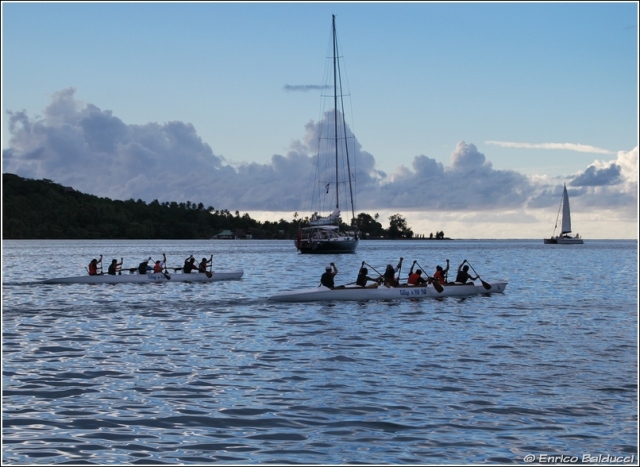
30/05/2008
KILLER GEESE....
In all the Society Islands, the mountain drops very steeply onto a narrow strip
of surrounding land, typically only 20-30 meters wide and split in two by the
road that tours the island itself.
All this flat land is divided in property lots which belong (probably since
centuries) to a family: one between the road and the mountain, and one between
the road and the sea.
The houses are in most of the cases very simple, just wooden walls and
corrugated iron-roofs, while the gardens are often very well kept and full of
multicoloured plants; beside the house, new and expensive cars, mostly big
japanese or american SUV's.
The poorer villages have a unkempt road and no SUV's.
A strange habit that we saw in Bora Bora are the ancestors' tombs in the lawn in
front of the houses!
In Tahaa, we spent a night moored to the buoys offered by the so-called "Yacht
Club" which is in fact a restaurant.
The property beside that of the yacht club is a Pearl Farm, and the two are only
nominally separated by low schrubs; signs encourage visitors to go in and see
the pearls.
A couple of days before, we had come here by car and Baby went into the Pearl
Farm courtyard welcomed, or so she thought, by some cheerful geese: she extends
a hand, and a goose attacks her, hissing like an angry cat, and bites her toe!!
(all documented by Keith of "Baccus" who was filming the supposedly charming
scene...)
When we came back with the boat, Baby went to see the geese well armed with some
stale baguette breads: it's not clear if that was to make friends or as a weapon,
fact is the geese did not bite...
05/06/2008
LEEWARD ISLANDS...
We left French Polynesia some days ago, and it's now time for a summary: the
leeward islands, then!
We arrived from Moorea very late because we could not force us to leave and we
went first to Huahine, which is supposed to be the less developed of the
leewards: indeed it is simple, but the town is welcoming and there are all basic
facilities. The lagoon can be navigated all the way down to the southernmost
point, where we anchored for some peaceful days (and one not-so-peaceful stormy
night!).
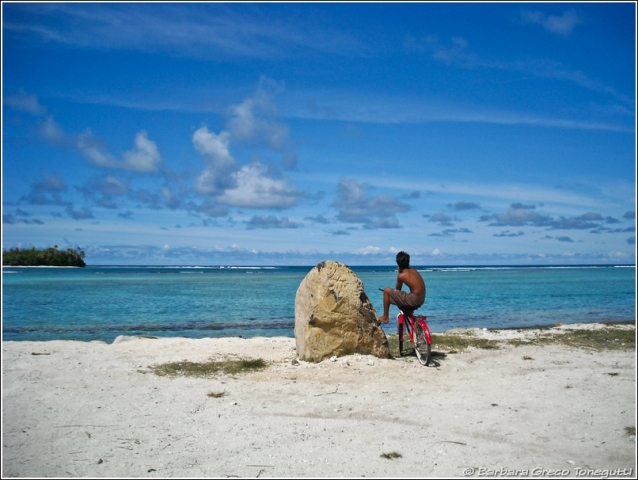
The scenery along the coastline is beautiful, especially along the east coast,
and the site of the seaside Marae is well kept and has also a small but
interesting museum.
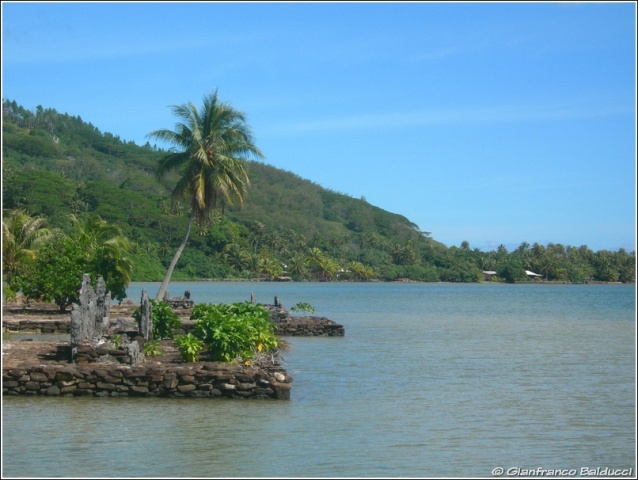
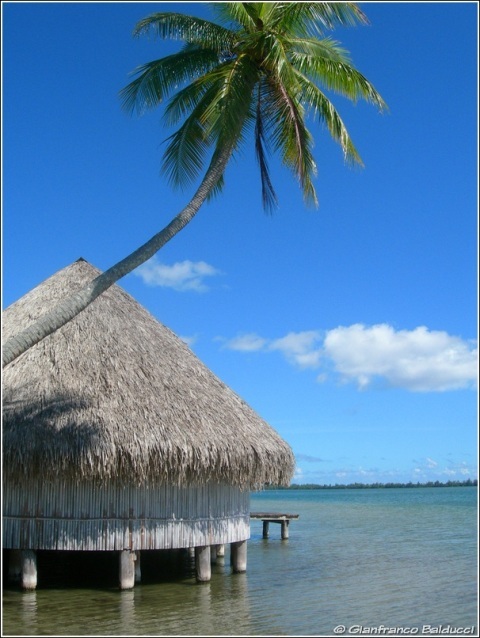
Having moved over to Raiatea, supposedly the best-equipped in terms of yacht
services, we found:
- no place in the town port
- a makeshift mooring in the charter yachts' marina, which is far away from town
- high prices!
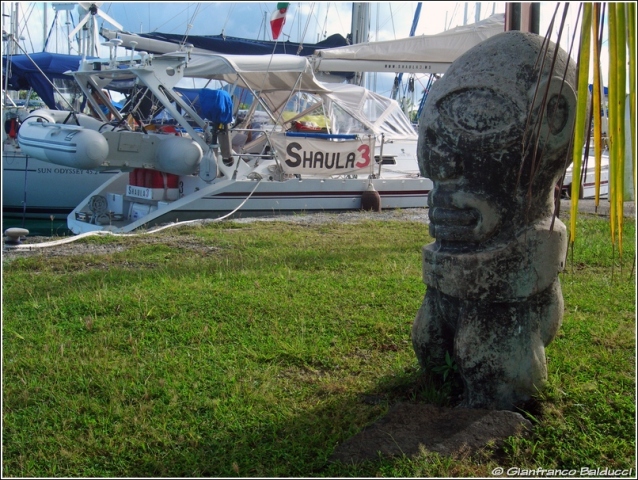
Shaula and Baccus guarded by their favourite "Tiki"
As a compensation, the tour of the island had two gems in store for us:
- the so-called Botanical Garden, which is a large stretch of land where
somebody planted every conceivable tropical plant, flower or fruit,
- the site of the Taputapuatea "international" Marae (it was a sort of United Nations of the
Polynesian people).
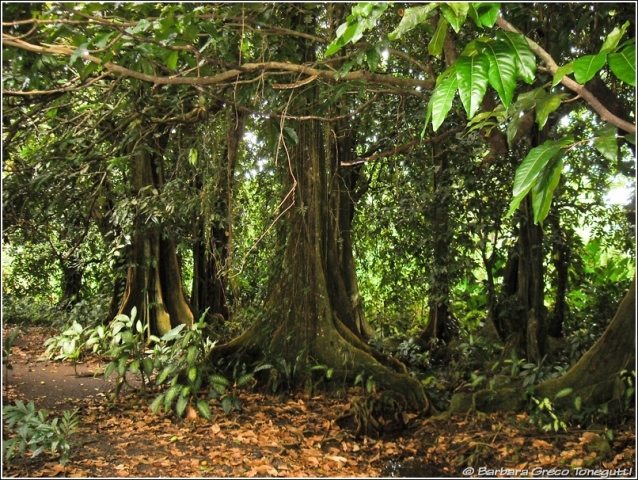
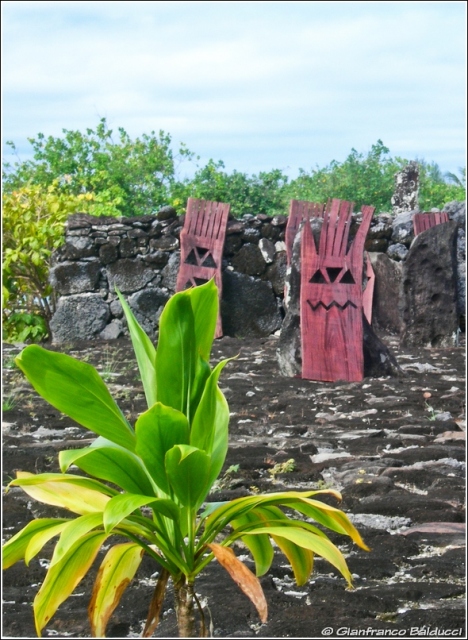
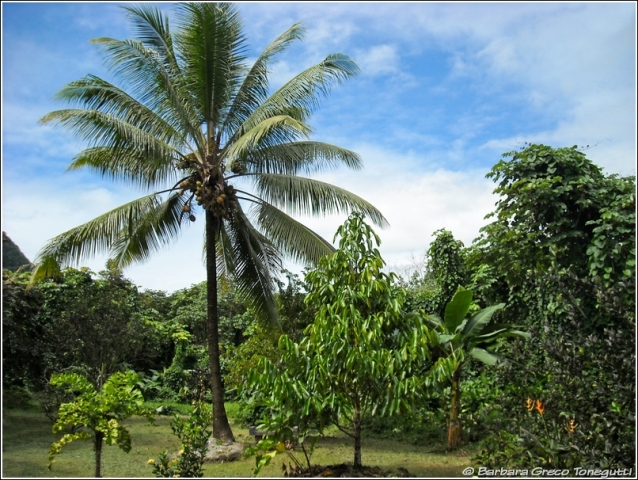
Raiatea and Tahaa are so close that they share the same coral reef: after having
anchored at the end of a very long harbour which is practically cutting the
island in two, we made the customary tour of the island that was not
particularly interesting.
After a couple of days, we went to day-anchor near "Private Island", where there
is a passe among two islands which is called "coral garden", and for a reason!
Water is just a couple of feet deep, and you have to brace against a strong
current but then you discover that all you need to do is crouch in the water and
wait a few seconds for the fish to start swimming around you: an experience
similar to a dive on the reef, but in very shallow water!
And finally, Bora Bora: after having seen all the other islands, and warned
about it being "very expensive and tourist-oriented" we did not expect much, but
we had to change our mind.
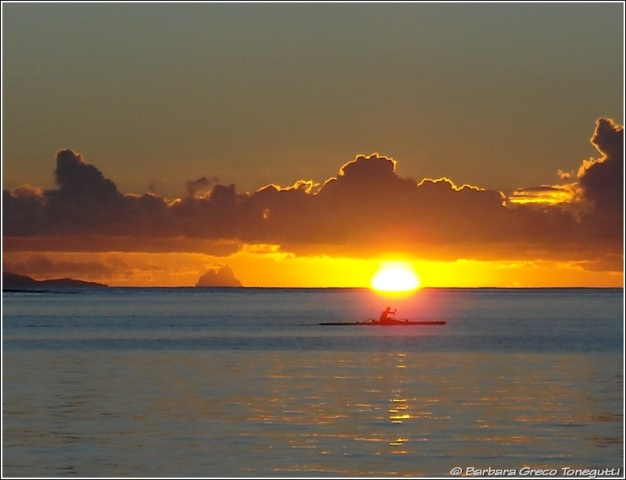
In the distance, the peaks of Bora Bora
Unlike the other Society Islands, Bora Bora combines a central, hilly and highly
spectacular island with inhabited, large islets along the reef, like in the
atolls of the Tuamotu islands.
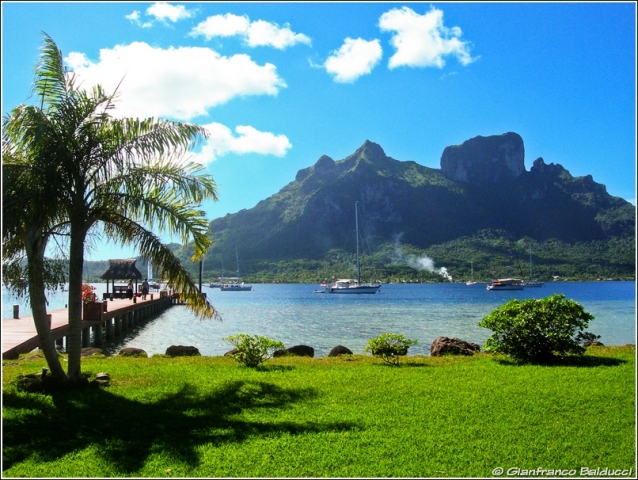
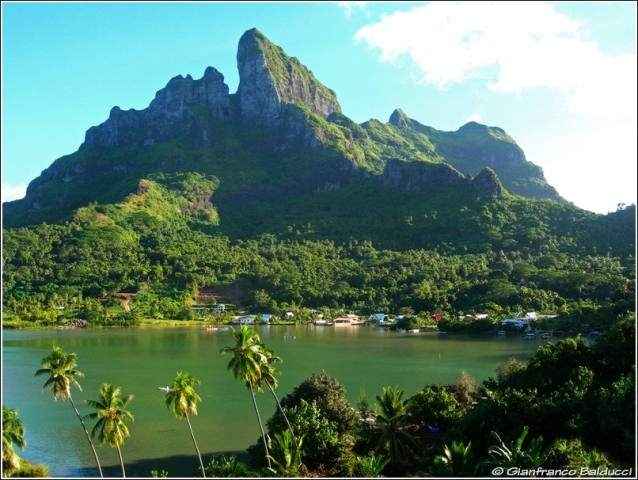
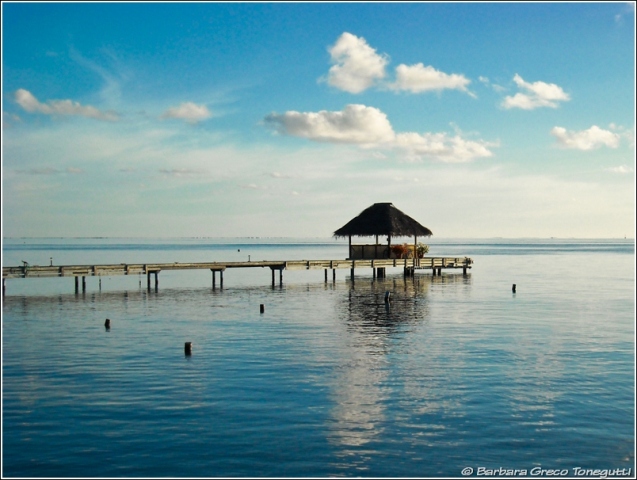
The water in the lagoon is cristal-clear and swarming with fish of all kinds and
colours.
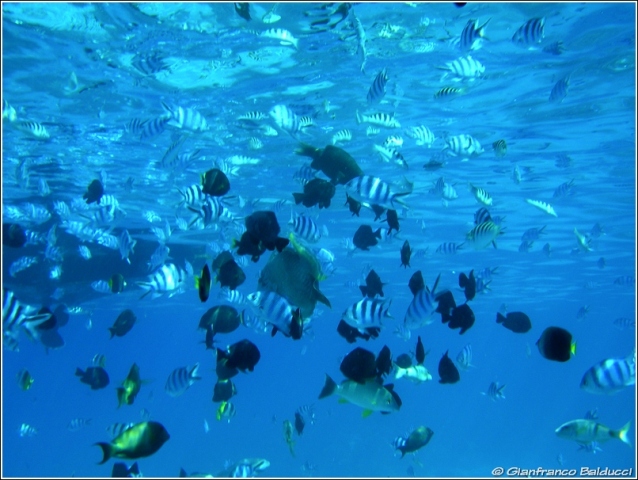
Outside the pass, a swim among the sharks gives some emotions, and the coral is
arguably the more Beautiful we have seen so far.
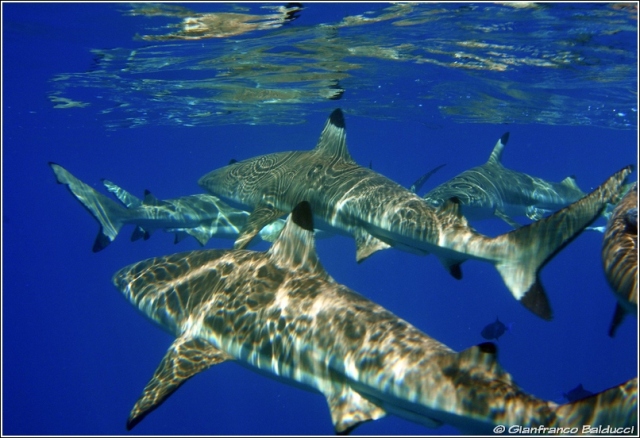
The Americans made the fortune of this island when they occupied it during the
war, building an airport that remained the only one in the whole of Polynesia
for quite some time, but the place deserves its fame.
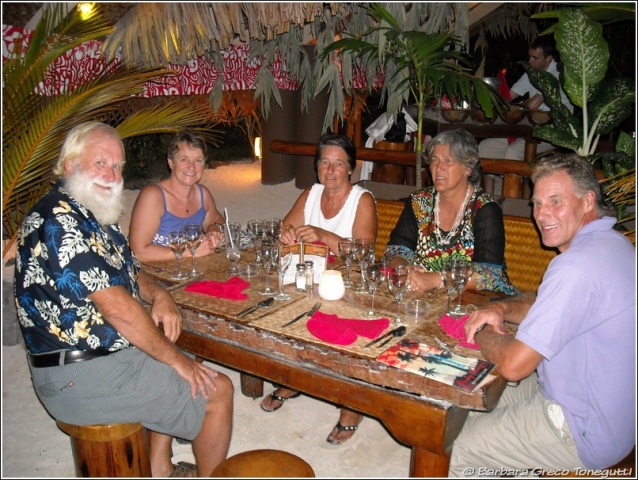
We allow ourselves an "elegant" dinner at the renowned "Bloody
Mary" restaurant
We would have stopped a few more days, but time was running very short and we
had to weigh anchor and head towards Tonga, with a planned intermediate stopover
in Aitutaki, Cook Islands.
CONTINUE
READING...
|